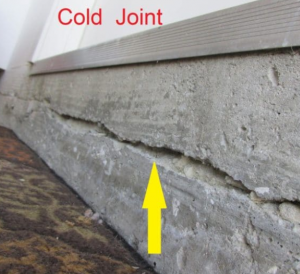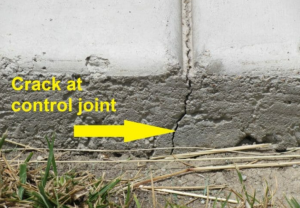Repair of Cold Joints In Concrete
What exactly is a cold joint and how do we determine the repair of cold joints? By definition, cold joints are two faces of concrete adjacent to each other not acting monolithically. In other words, they are separate concrete sections that otherwise should’ve acted as one.
That being said, the face that they share boundaries with can be a source of weak spot. Due to stress, the vicinity around the cold joint will gradually erode over time, especially when it’s exposed to inclement weather — a source of water seepage which in turn may lead to persistent structural cracks.

Cold joints usually occur during large pours when supply of concrete suddenly becomes unavailable. As the first batch of concrete starts to harden, it becomes impossible for the next batch to combine with it, creating a cold joint.
Our Cold Joint Repair Methodologies
We have a variety of repair methodologies for every type of structural defects imaginable. But in this case, it will vary depending on its location in the structure — whether if it’s on the building frame or not. Building frames are all the load-bearing elements of the structure such as slab, girder, and column. Those not included are what we call non-load-bearing elements.
Scenario 1: Cold joint appears at a building frame.
In this case, our goal here is to fill-out the cavities inside the cold joint to establish a strong mechanical bond between the two separate faces. In order to do so, we will inject a high-quality, strong resin material (polyurethane or epoxy) via injection ports using a high-pressure resin pump. If successful, all cavities within the cold joint are filled-out completely — creating a much stronger frame.
Step 1: Find out the depth of crack of the cold joint by v-cutting.
- Naturally, a v-cut section will reveal the crack depth. The deeper the crack, the wider the v-cut section would be.
- The crack depth will also determine the depth of embedment of injection ports — usually between 25 to 50 mm.
Step 2: Drill holes for injection ports.
- These holes are spaced typically around 200 to 300 mm. Make sure that all holes are clean prior to insertion of injection ports.
Step 3: Insert injection ports and fix them snugly in place
- These injection ports vary in shapes and sizes but all of which have the same purpose — they serve as connecting tubes to the resin pump.
Step 4: Seal off the v-cut section, and the space between the ports and hole.
- The same material to be injected can also be used as a patching compound because it cures and hardens quickly. The purpose of which is to stop the resin from seeping out somewhere along the joints or holes due to high-pressure. It usually cures after 8 hours.
Step 5: Connect the pump hose to the injection port and start pumping resin.
- Make sure that the cavities are completely filled-out by watching the adjacent injection port ooze excess resin. When it does, that section of the cold joint is filled completely.
- Continue until all injection ports are filled.
Step 6: Inspection and assessment.
Scenario 2: Cold joint appears at a non-load-bearing element.
Our team of experts will assess whether the cold joint appears on a load-bearing or non-load-bearing element.
If such is the case, the problem can be treated as a simple water leakage problem. Hence, a simple waterproofing methodology is all it takes. Depending on the scenario outlined below, this corresponding waterproofing material must be used.
- Consistent water on cold joint: Hydraulic Cement
- Cold joint exposed to weather (small areas): Elastomeric Waterproofing
- Cold joint exposed to weather (large areas): Elastomeric Waterproofing Membrane
Repair of Cold Joints Key Takeaways
- If the cold joint appears is on the building frame, an injection of high-quality resin is appropriate.
- If the cold joint appears in a non-load-bearing element such as brick walls, it can be treated as a simple water leakage problem.
Contact us!
We are situated in Liverpool and if you have further questions regarding our services, feel free to contact us. Our team of experts are more than willing to help you out! Remember, a structural consultation once in a while, keeps all the crack away.

